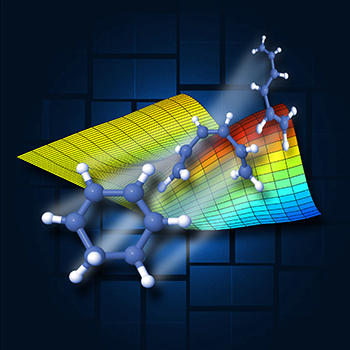
n illustration of the shape changes that occur when a ring-shaped molecule is broken open by light. Credit: SLAC National Accelerator Laboratory
X-ray laser scattering can uncover a molecule’s structure before and after a chemical reaction, but the molecule’s transition to its final state happens too fast for the laser’s long pulse duration and insufficient photon flux. Now, scientists are using the U.S. SLAC National Accelerator Laboratory’s LINAC coherent light source (LCLS)—an X-ray free-electron laser—to create “movies” of a molecule’s transition states during a chemical reaction (Phys. Rev. Lett., doi: 10.1103/PhysRevLett.114.255501).
For the study, the scientists, led by SLAC’s Mike Minitti and Peter Weber of Brown University, USA, scattered femtosecond-width, synchrotron-intensity pulses from the LCLS off of molecules of gas-phase 1,3-cyclohexadiene (CHD). Gas-phase molecules are ideal for this type of research because they are loosely packed and less likely to bump into each other and obscure structural changes than solid- or liquid-phase molecules. CHD’s ring-shaped molecules are common in organic chemical reactions and play a key role in many biological processes and photochemical switches.
The experiment was performed by placing low-pressure CHD vapor in a custom scattering chamber. The scientists broke a single bond between two carbon atoms in the CHD molecule with an ultrafast ultraviolet laser pulse. They observed the structural changes of the reaction by directing hard LCLS X-ray laser pulses at the molecule at 30-femtosecond time intervals at a wavelength of 1.5 angstrom. (The wavelength corresponds to the maximum spatial resolution.)
The team compiled about 100,000 LCLS diffraction patterns, and used them to create computer simulations of how the CHD molecule most likely unfurls into a nearly linear 1,3,5-hexatriene molecule in about 80 femtoseconds. Although the LCLS’s wavelength didn’t allow for atomic-level resolution, numerical simulations allowed the scientists to calculate the possible molecular reaction paths and compare them with the collected diffraction patterns. Using nonlinear least-squares optimization, they were able to eliminate all but a few paths. From these data, they constructed movies of the four dominant trajectories of the molecule’s evolving geometrical structure.
The video below, from SLAC, shows how the CHD unravels after it’s split open by light:
{^youtubevideo|(width)425|(height)264|(rel)False|(autoplay)False|(fs)True|(url)http://www.youtube.com/watch?v=HhmBKd-_sRM|(loop)False^}
Minitti says “LCLS is a game-changer in giving us the ability to probe this and other reactions in record-fast timescales, down to the motion of individual atoms.”
